Rain barrels are a great way to capture the best type of water you can give your plants and gardens, but how do they work?
This is a very common question that I get from readers, so I thought I would write a quick post about it.
Below I’ll tell you what their purpose is, how they work, and how to use a rain barrel, so you’ll know exactly what to expect. Plus I’ll give you plenty of tips, as well as other great uses for the water you capture.
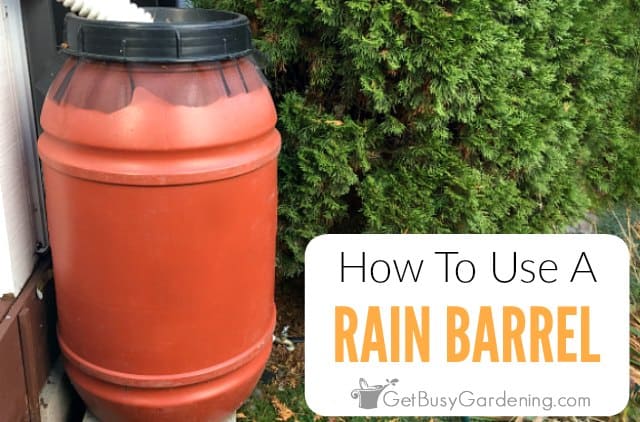
What Are Rain Barrels Used For?
The purpose of a rain barrel is to capture and store rainwater as it runs off a roof and flows through the gutters on your house, garage, shed, or other structure.
There are lots of benefits to having a rain barrel, and you can use the water for many things. I use it for my houseplants and outdoor potted plants, and to keep my garden ponds and water features full during the summer.
But many people set up larger systems so they can irrigate their lawn and gardens. You can also use the water for household chores, like washing the windows or your car.
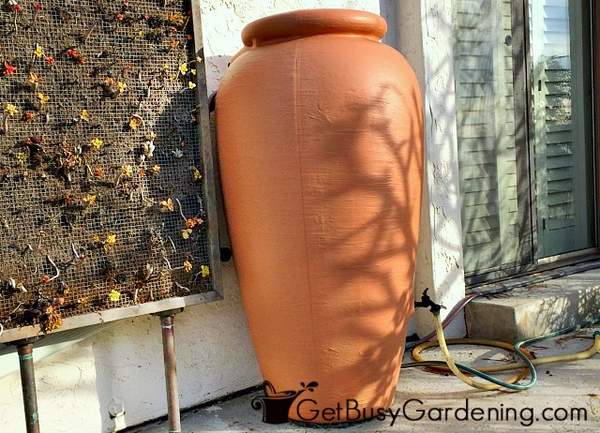
How Rain Barrels Work
Rain barrels capture water through an opening on the top or side, which comes from a gutter attachment or piece of downspout tubing.
Each time it rains, the barrel fills up with water from the downspout attachment. Then the water will sit in there until you’re ready to use it.
They don’t have any type of a pump system, and rely solely on gravity to get the water out. Learn exactly how to install a rain barrel here.
What Happens When A Rain Barrel Is Full?
Most rain barrels have some kind of a valve near the top to prevent it from overflowing. But during a heavy rainfall, many times the overflow valve can’t keep up, and excess water can bubble over the top of the barrel instead.
That’s not an issue for mine, because we installed one of them next to the garage, and the other is on the side of our deck. So the overflow simply runs downhill into the grass.
However, if you plan to install yours next to the foundation of your house, and you have a basement, then I definitely recommend using a gutter attachment or installing a diverter kit to avoid any risk of flooding.
That way, the diverter will shut off when your rain barrel is full, and the excess water will simply flow through the gutter like it normally would.
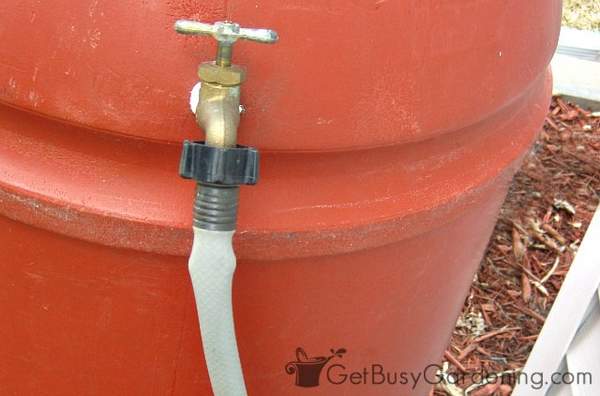
How To Use A Rain Barrel
To use your rain barrel, you can simply turn on the spigot at the bottom, and let the water flow out naturally. Here are some tips and things to keep in mind so you know what to expect:
- For the best water pressure, elevate your barrel using a stand or some other strong, sturdy, and level platform.
- If you attach a hose to your rain barrel, you’ll only be able to use it if you keep it below the level of the spigot.
- They don’t have a pump, so the water pressure is determined by gravity, and it won’t flow uphill.
- The farther away you run a hose from your rain barrel, the slower the water pressure will be.
- Because of the weight of the water, it will flow out much faster when the barrel is full than it will as it empties.
Related Post: Winterizing Your Rain Barrel In 4 Easy Steps
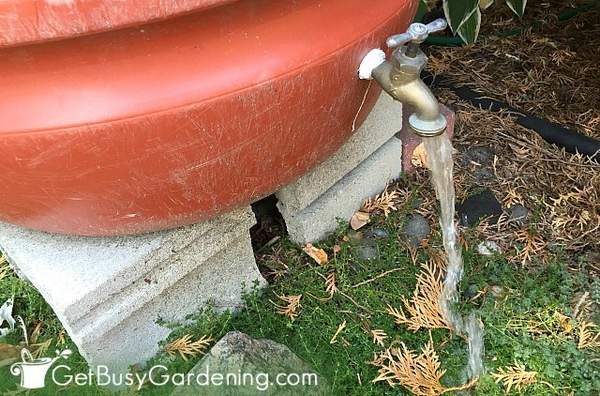
Rain barrels are easy to use, and work great to capture water that you can use for your plants and garden, or household chores (and save on your utility bills!).
More About Watering Plants
In the comments below, share your tips on how you use your rain barrel, and how well it works for you.
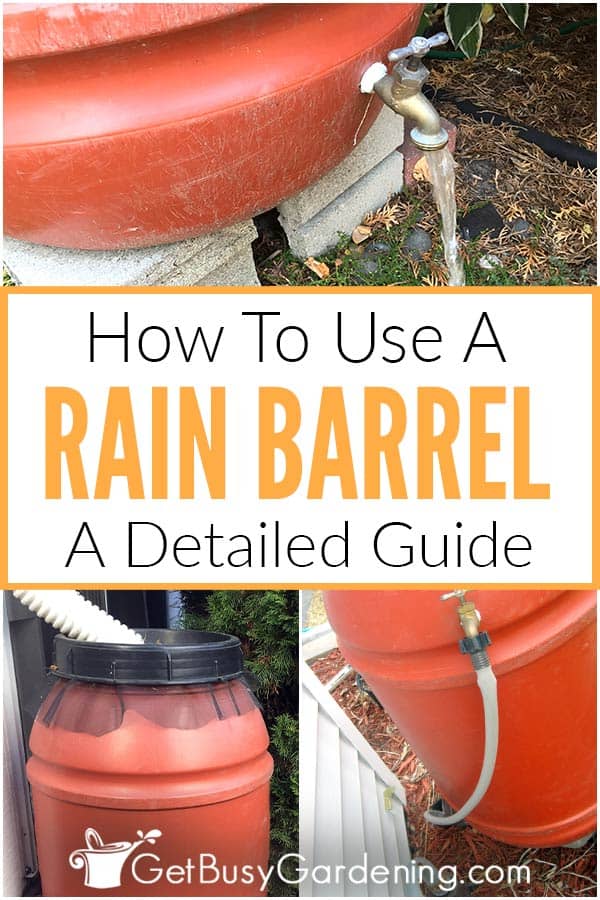
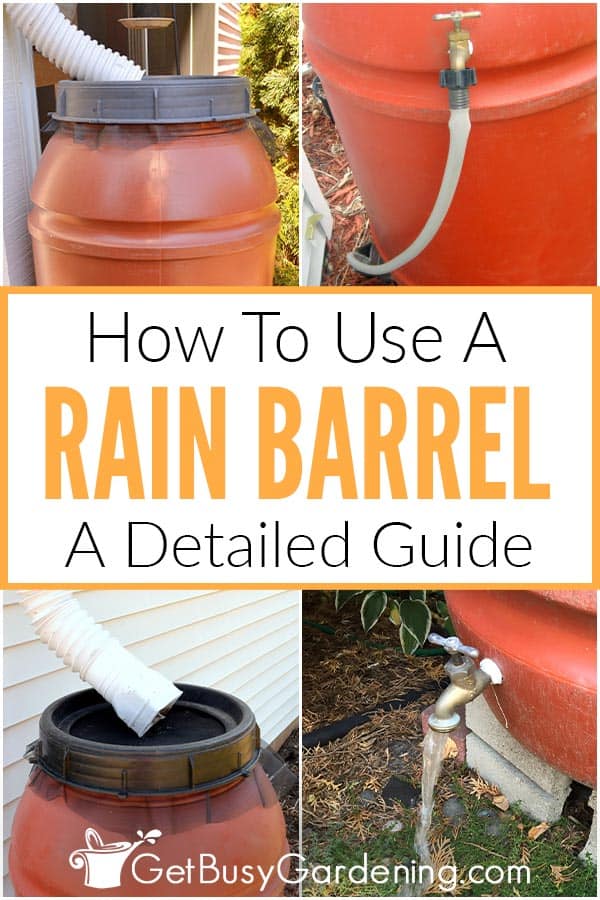
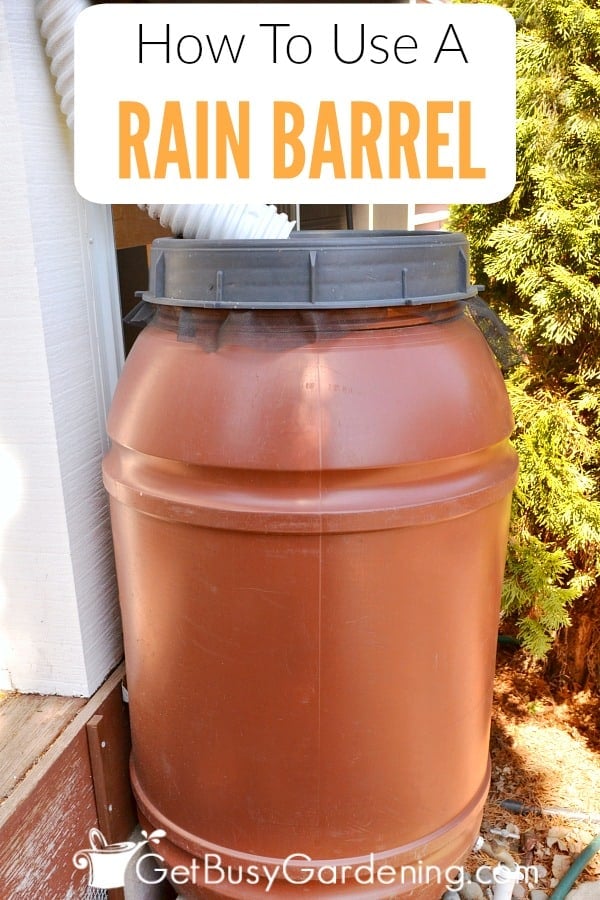

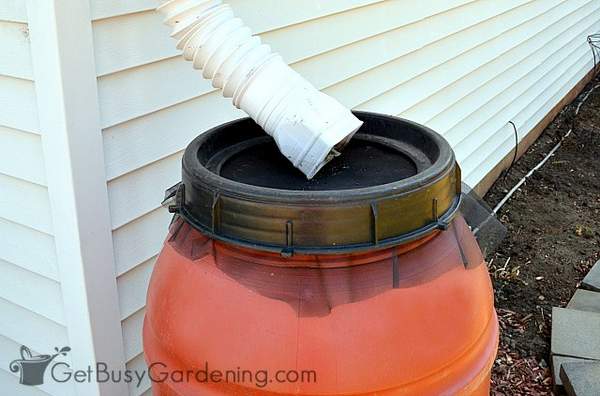

Jeff Van Zanten says
Hi Amy,
I am convinced using rain barrels are a good idea, especially in California with the droughts.
How long can you keep rainwater in the barrel before algae, mold or other growth can become a problem?
What is your recommendation for length of time for water storage.
Thanks.
Jeff
Amy Andrychowicz says
In Minnesota it rains often enough to flush the barrel and refresh the water, so I don’t have issues with it becoming stagnant. If you keep it out of the sun, and protect the water so bugs and other debris can’t get in there, it will last much longer than it would if you kept it open. I have seen a lot of rain barrels in CA, and some people have very sophisticated systems that I’m sure are made to keep the water from going bad, and also prevent it from evaporating. So I guess my point is that you may want to look into something that is more enclosed, rather than just a standard rain barrel like mine. You’d probably also want something much larger since it won’t be filled up very often, and you would probably use it up pretty quickly if you just had a small barrel.
linda says
Hi Amy! Thank you for this information! I will tell you why I am considering, the rain barrel. I do not have gutters or downspouts on my home. Do you think I could use the barrels to collect the rain and then divert the water away from my house? In the meantime I would love to learn more about gardening! Thank you for your time!
Amy Andrychowicz says
You’re welcome! Without gutters, it will be difficult to position the rain barrel to collect water from the roof. You might be able to attach a rain chain to one corner of the roof and direct that into the barrel to collect some rainwater. But if your goal is to divert the water away from your house, then you definitely need gutters.
Merrie Pritchett says
Can rain-barrel water be used for other things besides watering plants? Such as cooking, drinking, showering and washing my hair. (I ask, because I thought rainwater was soft.)
Amy Andrychowicz says
While you certainly could use your collected rainwater for things like washing the car or windows as I mentioned above, I would not use it for washing your hair or showering, and definitely do NOT drink it! The water sitting in the barrel is not clean enough for those uses.
Craig Maw says
Hi Amy
I have a single rain barrel that i use for watering.Now that fall is here i want to winterize my system. That means i empty the rain barrel and move it to storage. My dilemma is the spout for the barrel is 48 inches off the ground.The lawn is 16 feet away over a concrete patio.Last year i tried a couple of lengths of downspout assembled and placed at a considerable drop so when it freezes the roof water or snow melt will flush it. My problem is i used an old table to secure the downspout to it is not an acceptable for this season. Any ideas?
Thanks!
Amy Andrychowicz says
Humm… it’s weird that your downspout doesn’t have a spot to drain that is closer to the house. I’m not really an expert in gutters, sorry. But I would talk to someone who knows the best way to attach a gutter/downspout for a long distance like you have. Perhaps a home improvement or hardware store would be the best place to start.
Suze says
I just got two rain barrels. I love them, but the diverters are not working as they should. One of the downspout diverters does not divert as intended, and during a heavy rain, the water fills up my barrel and then spills out onto the ground (not back up the diverter, which seems to have been a waste of money). And my 2nd problem: I have an extra hose attached to the top spigot of my barrels to help with overflow. But in order to get the water to flow out of that top hose, I have to manually jiggle the hose *each time* and get the water flowing out of the barrel by moving the hose around, after which the water flows out of that top spigot. Impractical for nighttime rains or during thunderstorms.
Amy Andrychowicz says
Bummer your rain barrel isn’t working quite right. I would replace the hose on the overflow spigot, or the spigot itself, and also see if you can exchange the faulty downspout diverter for a new one. They really do work very well, it just sounds like you got a lemon.
Will says
I have the same issue of having to jiggle the overflow hose (release pressure?) to allow the water to flow freely. What is that all about?! Also, I live in the Northeast and am about to go thru our first rain barrel winter. The plastic barrel is adequately raised and has a hose attached at the bottom to drain. Can I just open the valves during the winter and not risk damaging the barrel? Or will I have to get a gutter diverter and run more gutter drainage?
Amy Andrychowicz says
I’m not sure why your overflow hose isn’t working properly. Maybe there’s too much pressure/suction building up inside of the barrel once it becomes full? I’ve never had that problem with mine, but it’s completely open on the top, so there’s no way it could build up suction like that. I don’t know how cold it gets where you live, but here in MN, I must store my rain barrel during the winter or it will freeze solid (even if I had both of the spigots removed). But we have several months of below zero temps, and it can even get down to -20/30 below. But if your winters are pretty mild, then it should be fine just leaving everything open as you describe, as long as the ice doesn’t build up in there. But if it’s consistently below zero, then I would remove it and store it.
Dandy says
I have two rain barrels. I had to remove mine and clean them up they they were really stuffed with dirt and stuff that came of the roof.
Amy Andrychowicz says
Yes, that is pretty common, especially if you don’t have any type of a screen over the opening where the gutter empties into the barrel. I clean mine every fall when I remove them for winter storage. I have screens over mine, so they stay pretty clean. But some roof debris still finds its way inside.
Paula Feldman says
Which is better a wooden rain barrel or a plastic as pictured here? Which lasts longer if kept clean or mold?
Amy Andrychowicz says
I have never used a wooden rain barrel before, so I can’t speak from experience. However, I would expect that a plastic one would last longer.
Susan says
Can a rain barrel be placed in direct sunlight or should it be in the shade? I live in NE Iowa where the most easily accessible downspout is on the west side in direct sunlight.
Amy Andrychowicz says
Shade would be ideal to help the rain barrels last longer, and also prevent algae growth. However, mine sit in the sun for a good part of the day (one on the east side of the house, and one on the west side), and besides being a little faded, have faired just fine for well over 10 years.
Maureen says
Can i use a rain barrel just for the purpose to drain water away from the house. If i set it up with it going directly in the rain barrel and leave my hose connected to the spigot and when its going to rain just put the hose that’s attached down the driveway and leave the spigot open. I will use the water for gardening, however looking for a way to divert excess water from the house. Would this work?
Amy Andrychowicz says
I think it would work just fine during light rain. However, during a heavy rainfall, rain barrels fill up very quickly, and I don’t think it will drain from the spigot fast enough to keep it from overflowing. I recommend you get a gutter attachment that will shut off the flow of water to the barrel once it’s full, so the water will go through the gutter as it normally would.
shelley Sheridan says
My water will not flow through the hose. Must the rain barrell be lifted on blocks to allow gravity for the water to flow???
Amy Andrychowicz says
Yes. The rain barrel has to be elevated in order for the water to flow, and/or the entire hose has to be lower than the spigot on the barrel. The higher you elevate the barrel, the faster the water will come out of the hose.
kathleen Forrest says
My barrel is only 1/3 full so it will not run through my hose. Any suggestions?
Amy Andrychowicz says
Do you have it raised off the ground at all? As long as the water is higher than the hose, it should still come out. It will be slower than it would if the barrel was full though. Also, when mine gets really low, sometimes I need to tip the barrel towards the hose to speed up the water flow. Be careful though, cause the water can be pretty heavy. 🙂
James says
Here in the UK, we use a thing called a diverter- so we cut the downpipe from the gutter, and put this device between the cut ends at about the height of the top of the rain barrel. Then a flexible pipe connects this to the rain barrel inlet. Do you use these too?
Amy Andrychowicz says
Yes, we have gutter diverters for rain barrel here in the US too, and they work great!
Capt. Brigg Franklin says
I currently have five rain barrels all located 10 feet above ground. Since I am in a two story house the roof gutters are all on the second story roof line and easily fill the rain barrels. This provides lots of water pressure for my whole garden.
Amy Andrychowicz says
WOW, your rain barrel setup awesome! Do you have to take them down to winterize them?
Capt. Brigg Franklin says
We have very mild winters here in Washington state, so I just leave the drain valve open all winter and the water drains out into my yard which has very sandy soil. When my barrels fill in summer or winter I have an overflow pipe that also drains out into the yard.
We are building a similar rain collection system out in the Wildlife botanical Gardens where I volunteer.
Amy Andrychowicz says
Very cool! Have fun install the new rain collection system! 🙂
MI Patriot says
My ideal rainwater collector would be one of those big square tanks in the metal mesh and hold about 250 gallons. Unfortunately, I don’t have the space or a fork truck to move it around. What I did do was take 3 40 gallon garbage cans and line them up by the downspout. I took a length of rigid PVC and drilled holes about 4 inches down from the top and then put the PVC in the hole in one barrel and into the hole of the next barrel. They act as overflow valves. A good rain will fill all 3 and then some. I did have a rain barrel under a down spout for awhile and I was happy. It wasn’t until we got covered gutters that I realized just how much rain I was missing out on. They work great and I’ve got water that our local DPW can’t charge me for.
Amy Andrychowicz says
Wonderful, I love the creative alternative rain barrel setup you came up with using garbage cans. Sounds great, thanks for sharing!
Stasher says
We have two barrels!
Amy Andrychowicz says
Awesome! 🙂
joann wilford says
Hello,
I have a rain barrel and fully submersible pump and I was wondering if I can leave the pump in the rain barrel when not in use as it takes me a while to dig out the pump and hose and I feel it could be easier if I just left the pump in, as I cant find any instructions to say I can or I can’t I am asking for your help.
Thank you for your time
Joann
Amy Andrychowicz says
Hi Joann,
If your rain barrel pump submersible, I think you could leave it in there all the time for sure. As long as it doesn’t freeze to the bottom in the winter, the pump will be fine.